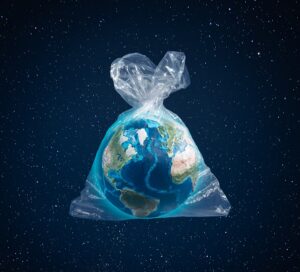We are rightly and finally waking up to climate change. Meanwhile, another environmental disaster is unfolding… plastic pollution.

The ubiquity of plastic in our daily lives has contributed to its overuse and mismanagement, leading to severe environmental consequences. Single-use plastics like bottles, bags, and packaging are major contributors to plastic waste due to their short lifespan and limited recycling rates. Improper disposal and lack of recycling infrastructure exacerbate the problem, allowing plastic waste to accumulate in the environment.
Plastic pollution is not just an isolated environmental issue; it is intricately linked to the three greatest global environmental crises of our time: the climate crisis, biodiversity loss, and chronic pollution. The urgency to confront plastic pollution head-on stems from its far-reaching impacts across ecosystems, wildlife, and human health.
The ongoing negotiations for the Global Plastic Treaty are at a critical juncture, marking the fourth of five scheduled meetings. The discussions around objectives, structure, and key measures are pivotal. Without agreement on these fundamental aspects, the ambitious goal of finalizing the treaty text by the end of 2024 may face significant challenges.
Moving Beyond End-of-Life Waste Management
Historically, efforts to address plastic pollution have focused heavily on the disposal phase, emphasizing better waste collection systems, recycling, incineration, and landfill capacity expansions. While these efforts are crucial for managing plastic waste, they fall short in preventing the release of pollutants earlier in the plastic lifecycle. Moreover, they do little to mitigate the significant climate impacts associated with plastic production and use.
Source Reduction as the Key Strategy
To truly combat plastic pollution comprehensively, we must shift our focus towards tackling it at its source. This means revaluating production processes, material choices, and consumption patterns to reduce plastic use and dependency. The Global Plastic Treaty presents a unique opportunity to prioritize source reduction strategies alongside end-of-life waste management.
Key Strategies for Source Reduction:
Design for Circularity: Encouraging product design that prioritizes recyclability, reuse, and durability to extend product lifecycles and minimize waste generation.
Promotion of Alternatives: Investing in research and development of sustainable alternatives to single-use plastics, such as biodegradable materials and innovative packaging solutions.
Regulatory Frameworks: Implementing policies and regulations that incentivize sustainable production practices, reduce plastic packaging, and promote eco-friendly alternatives.
Consumer Awareness: Educating consumers about the environmental impacts of plastic consumption and empowering them to make informed choices through awareness campaigns and labelling initiatives.
Collaborative Action for a Sustainable Future
The Global Plastic Treaty serves as a platform for international collaboration, bringing together governments, industries, NGOs, and consumers to collectively address plastic pollution. By setting clear objectives, establishing robust mechanisms for monitoring and enforcement, and fostering innovation and knowledge-sharing, the treaty can drive meaningful progress towards a plastic-free future.
As we navigate the challenges posed by plastic pollution and its interconnectedness with global environmental crises, prioritizing source reduction strategies within the framework of the Global Plastic Treaty is paramount. By addressing plastic pollution at its source, we not only mitigate its immediate impacts but also contribute significantly to climate mitigation, biodiversity conservation, and pollution prevention, paving the way for a more sustainable and resilient planet for future generations.
Bronwyn Reid | May 2024
